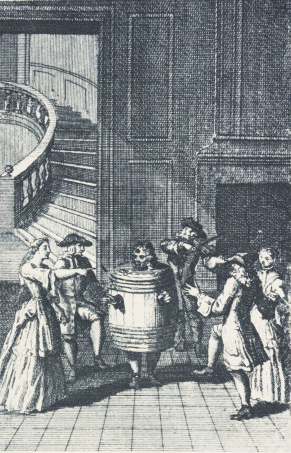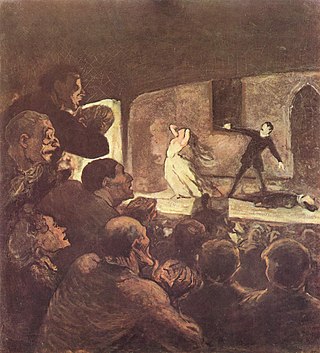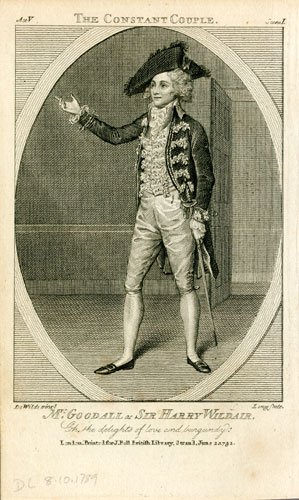
"Restoration comedy" is English comedy written and performed in the Restoration period of 1660–1710. Comedy of manners is used as a synonym for this. After public stage performances were banned for 18 years by the Puritan regime, reopening of the theatres in 1660 marked a renaissance of English drama. Sexually explicit language was encouraged by King Charles II (1660–1685) personally and by the rakish style of his court. Historian George Norman Clark argues:
The best-known fact about the Restoration drama is that it is immoral. The dramatists did not criticize the accepted morality about gambling, drink, love, and pleasure generally, or try, like the dramatists of our own time, to work out their own view of character and conduct. What they did was, according to their respective inclinations, to mock at all restraints. Some were gross, others delicately improper.... The dramatists did not merely say anything they liked: they also intended to glory in it and to shock those who did not like it.

Elizabeth Barry was an English actress of the Restoration period.

A modern melodrama is a dramatic work in which the plot, typically sensationalized and for a strong emotional appeal, takes precedence over detailed characterization. Melodramas typically concentrate on dialogue that is often bombastic or excessively sentimental, rather than action. Characters are often flat, and written to fulfill stereotypes. Melodramas are typically set in the private sphere of the home, focusing on morality and family issues, love, and marriage, often with challenges from an outside source, such as a "temptress", a scoundrel, or an aristocratic villain. A melodrama on stage, filmed, or on television is usually accompanied by dramatic and suggestive music that offers cues to the audience of the drama being presented.

Edward Kynaston was an English actor, one of the last Restoration "boy players", young male actors who played women's roles.

Venice Preserv'd is an English Restoration play written by Thomas Otway, and the most significant tragedy of the English stage in the 1680s. It was first staged in 1682, with Thomas Betterton as Jaffeir and Elizabeth Barry as Belvidera. The play was soon printed and enjoyed many revivals through to the 1830s. In 2019, the Royal Shakespeare Company staged a modern adaptation, Venice Preserved, at the Swan Theatre, Stratford-upon-Avon.

Restoration literature is the English literature written during the historical period commonly referred to as the English Restoration (1660–1689), which corresponds to the last years of Stuart reign in England, Scotland, Wales, and Ireland. In general, the term is used to denote roughly homogenous styles of literature that centre on a celebration of or reaction to the restored court of Charles II. It is a literature that includes extremes, for it encompasses both Paradise Lost and the Earl of Rochester's Sodom, the high-spirited sexual comedy of The Country Wife and the moral wisdom of The Pilgrim's Progress. It saw Locke's Treatises of Government, the founding of the Royal Society, the experiments and holy meditations of Robert Boyle, the hysterical attacks on theatres from Jeremy Collier, and the pioneering of literary criticism from John Dryden and John Dennis. The period witnessed news becoming a commodity, the essay developing into a periodical art form, and the beginnings of textual criticism.

Katherine or Catherine Philips, also known as "The Matchless Orinda", was an Anglo-Welsh royalist poet, translator, and woman of letters. She achieved renown as a translator of Pierre Corneille's Pompée and Horace, and for her editions of poetry after her death. She was highly regarded by many notable later writers, including John Dryden and John Keats, as being influential.

An epilogue or epilog is a piece of writing at the end of a work of literature, usually used to bring closure to the work. It is presented from the perspective of within the story. When the author steps in and speaks directly to the reader, that is more properly considered an afterword. The opposite is a prologue—a piece of writing at the beginning of a work of literature or drama, usually used to open the story and capture interest. Some genres, for example television programs and video games, call the epilogue an "outro" patterned on the use of "intro" for "introduction".

Margaret Hughes, also Peg Hughes or Margaret Hewes, was an English actress who is often credited as the first professional actress on the English stage, as a result of her appearance on 8 December 1660. Hughes was the mistress of the English Civil War general Prince Rupert of the Rhine.
The Fair Penitent is Nicholas Rowe's stage adaptation of the tragedy The Fatal Dowry, the Philip Massinger and Nathan Field collaboration first published in 1632. Rowe's adaptation, premiered onstage in 1702 and first published in 1703, was a great popular success through much of the 18th century, and was praised by critics as demanding as Samuel Johnson.

The Duke's Company was a theatre company chartered by King Charles II at the start of the Restoration era, 1660. Sir William Davenant was manager of the company under the patronage of Prince James, Duke of York. During that period, theatres began to flourish again after they had been closed from the restrictions throughout the English Civil War and the Interregnum. The Duke's Company existed from 1660 to 1682, when it merged with the King's Company to form the United Company.
Thomaso, or the Wanderer is mid-seventeenth-century stage play, a two-part comedy written by Thomas Killigrew, The work was composed in Madrid, c. 1654. Thomaso is based on Killigrew's personal experiences as a Royalist exile during the era of the Commonwealth, when he was abroad continuously from 1647 to 1660.
Anne Marshall, also Mrs. Anne Quin, was a leading English actress of the Restoration era, one of the first generation of women performers to appear on the public stage in England.
Rebecca Marshall was a noted English actress of the Restoration era, one of the first generation of women performers on the public stage in Britain. She was the younger sister of Anne Marshall, another prominent actress of the period.
Katherine Corey was an English actress of the Restoration era, one of the first generation of female performers to appear on the public stage in Britain. Corey played with the King's Company and the United Company, and had one of the longest careers of any actress in her generation. In "The humble petition of Katherine Corey", she stated that she "was the first and is the last of all the actresses that were constituted by King Charles the Second at His Restauration."

An actor or actress is a person who portrays a character in a performance. The actor performs "in the flesh" in the traditional medium of the theatre or in modern media such as film, radio, and television. The analogous Greek term is ὑποκριτής (hupokritḗs), literally "one who answers". The actor's interpretation of a role—the art of acting—pertains to the role played, whether based on a real person or fictional character. This can also be considered an "actor's role," which was called this due to scrolls being used in the theaters. Interpretation occurs even when the actor is "playing themselves", as in some forms of experimental performance art.
Anne Shadwell was an English stage actor of the seventeenth century. She was one of the first English actresses to appear on stage following the Restoration She was one of six actors recruited in 1660 by William Davenant for the new Duke's Company, acting under her maiden name Anne Gibbs. Sometime between 1663 and 1667 she married the playwright Thomas Shadwell with whom she had four children. While some sources have her acting late into the century, it may be she effectively retired with the formation of the United Company in 1682. Her appearances had decreased since 1672. Following her husband's death in 1692 she was left the bulk of his estate. She had an investment in the Drury Lane Theatre in 1709, when she joined a petition to Queen Anne by the manager Christopher Rich, but nothing is known about her after this point.

Sentimental comedy is an 18th-century dramatic genre which sprang up as a reaction to the immoral tone of English Restoration plays. In sentimental comedies, middle-class protagonists triumphantly overcome a series of moral trials. These plays aimed to produce tears rather than laughter and reflected contemporary philosophical conceptions of humans as inherently good but capable of being led astray by bad example. By appealing to his noble sentiments, a man could be reformed and set back on the path of virtue. While the plays contained characters whose natures seemed overly virtuous and whose problems were too easily resolved, they were accepted by audiences as truthful representations of the human predicament.
Ibrahim, the Thirteenth Emperor of the Turks is a she-tragedy written by Mary Pix, first performed in 1696. Pix's first play, it purported to describe incidents in the life of Ibrahim, Sultan of the Ottoman Empire. The numbering is correct only if Mehmed the Conqueror is regarded as the first emperor, and the disputed reign of his son Cem is counted as well. The play has been called a "proto-feminist depiction of the power-struggle between a sultan and a seraglian woman".
The False Friend; or, the Fate of Disobedience is a she-tragedy written by Mary Pix, and first performed at Lincoln's Inn Fields in 1699. The play is a reworking of William Shakespeare's Othello. The original cast featured John Bowman as Viceroy of Sardinia, John Verbruggen as Emilius, John Thurmond as Lorenzo, John Hodgson as Bucarius, Joseph Harris as Roderigo, Elizabeth Barry as Adellaida, Elizabeth Bowman as Appamia, Anne Bracegirdle as Lovisa, and Abigail Lawson as Zelide.












